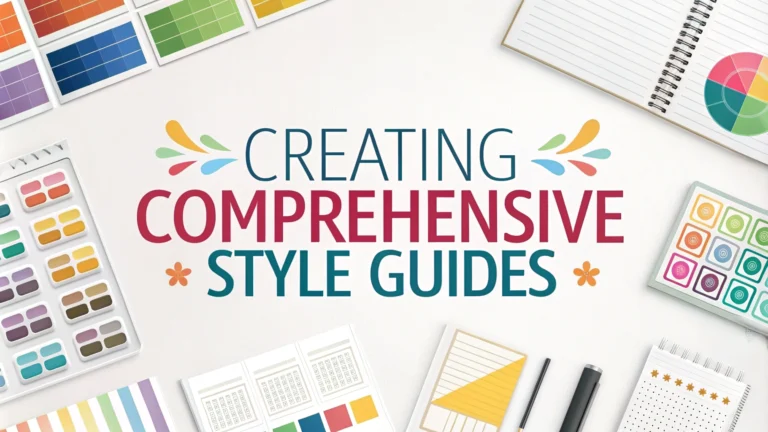A style guide acts as the foundation for maintaining brand consistency across all visual elements and design decisions.
Building an effective style guide for logo design requires systematic documentation of every design element, from color codes to spacing rules.
Essential Elements of a Logo Style Guide
- Logo variations and versions
- Color palette with exact codes (RGB, CMYK, Pantone)
- Typography specifications
- Minimum size requirements
- Clear space rules
- Do’s and don’ts for logo usage
Logo Variations
Every logo needs multiple formats to ensure proper display across different platforms and materials.
- Full-color primary version
- Black and white version
- Reverse (white) version
- Single-color variations
- Horizontal and vertical layouts
Color Specifications
| Format | Usage |
|---|---|
| Pantone | Print materials |
| CMYK | Standard printing |
| RGB | Digital displays |
| HEX | Web applications |
Typography Guidelines
Document both primary and secondary typefaces used in the logo and supporting brand materials.
- Font names and families
- Licensing information
- Alternative fonts for digital use
- Character spacing specifications
Size and Space Requirements
Set clear rules for minimum logo sizes to maintain legibility across all applications.
- Minimum print size: typically 0.5 inches in height
- Minimum digital size: typically 32 pixels in height
- Clear space: usually equal to the height of a logo element
Implementation Guidelines
Create a clear set of rules showing proper and improper logo usage.
- Approved background colors
- Placement guidelines
- File format requirements
- Examples of incorrect modifications
File Formats
- Vector files (AI, EPS, SVG): For print and scalable applications
- Raster files (PNG, JPG): For digital and web use
- PDF: For document sharing and printing
Distribution and Access
Store logo files and guidelines in an easily accessible digital asset management system.
Consider creating both detailed and quick-reference versions of the style guide for different user needs.
Regular Updates
Schedule annual reviews to ensure the style guide remains current with brand evolution and new media requirements.
Document all updates and changes in a version history section of the guide.
Contact Information
Include a dedicated email address or contact form for brand-related questions (example: [email protected]).
Additional Style Guide Considerations
Co-Branding Guidelines
Establish protocols for logo placement when used alongside partner brands or sponsorship situations.
- Minimum separation distances
- Size relationship rules
- Hierarchy guidelines
- Partnership lockup specifications
Digital Application Rules
Define specific requirements for digital platforms and social media usage.
- Social media profile specifications
- Email signature formats
- Website favicon requirements
- App icon guidelines
International Usage
Include guidance for logo usage across different regions and cultures.
- Language variations
- Cultural considerations
- Regional color meanings
- Local regulatory requirements
Conclusion
A comprehensive logo style guide serves as the cornerstone of brand identity management, ensuring consistency across all touchpoints and applications. Regular updates, clear documentation, and accessible distribution channels help maintain brand integrity as organizations evolve.
Success in brand management relies on strict adherence to these guidelines while allowing enough flexibility to adapt to new marketing channels and technological requirements. The style guide should remain a living document that grows with the brand while preserving its core visual identity.
Key Takeaways
- Document all logo specifications comprehensively
- Maintain consistent application across platforms
- Provide clear guidelines for various usage scenarios
- Ensure accessibility of assets and documentation
- Review and update regularly to meet evolving needs
FAQs
- What essential elements should be included in a logo style guide?
A logo style guide should include primary and secondary logo variations, clear space requirements, minimum size specifications, approved color palettes with color codes, permitted and prohibited logo usage examples, typography details, and file format specifications. - How do you define logo clear space in a style guide?
Clear space is typically defined using a measurable unit from the logo itself, such as the height of a letter or symbol (x-height). This space should be maintained around all sides of the logo to ensure visibility and impact. - What file formats should be included in a logo style guide?
Essential file formats include AI (Adobe Illustrator), EPS (vector format), PDF, PNG (with transparency), JPG (for web), and SVG (scalable vector graphics). Both RGB and CMYK color versions should be provided. - How should color variations be presented in a logo style guide?
Color variations should include full color, monochrome, black, white/reversed, and any approved secondary color versions. Each should be presented with specific color codes in CMYK, RGB, Pantone, and HEX formats. - What are the most important logo usage rules to include?
Key usage rules include maintaining aspect ratio, not stretching or distorting the logo, using only approved colors, maintaining minimum size requirements, ensuring adequate contrast with backgrounds, and avoiding unauthorized modifications. - How do you specify minimum logo sizes in a style guide?
Minimum sizes should be specified in both digital (pixels) and print (millimeters/inches) measurements, ensuring the logo remains legible across all applications and reproduction methods. - What typography information needs to be included in a logo style guide?
Typography specifications should detail the exact fonts used, including font names, weights, and styles. Include both primary and secondary typefaces, along with usage guidelines and licensing information. - How should incorrect logo usage be demonstrated?
Include visual examples of incorrect usage, such as stretching, color alterations, rotation, added effects, pattern placement, and inappropriate backgrounds, each clearly marked as prohibited uses. - What co-branding guidelines should be included in a logo style guide?
Co-branding guidelines should specify proper logo placement, spacing between logos, size relationships, and hierarchy when used alongside partner logos or in sponsorship situations. - How should digital and social media logo specifications be addressed?
Include specific guidelines for social media profile pictures, favicon requirements, app icons, and digital advertising placements, with appropriate size specifications and format requirements for each platform.








